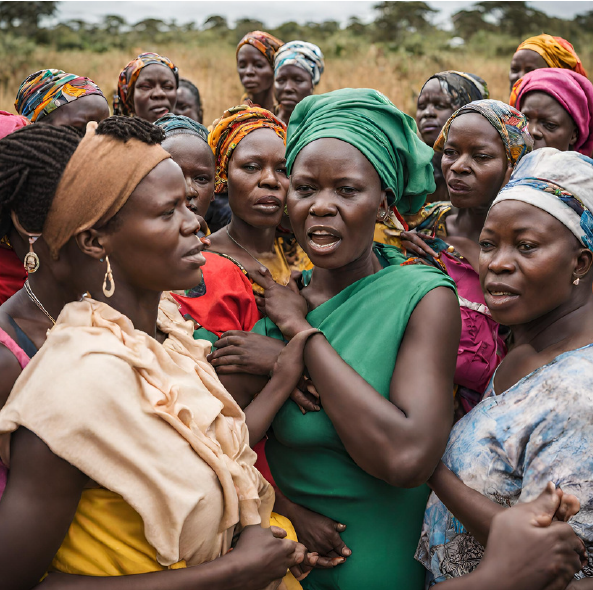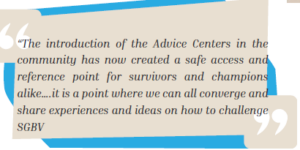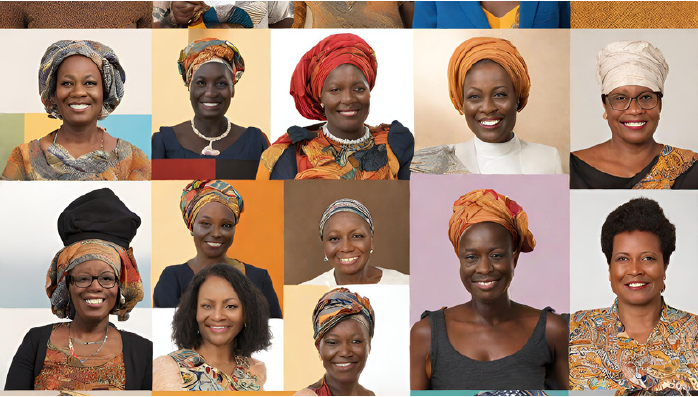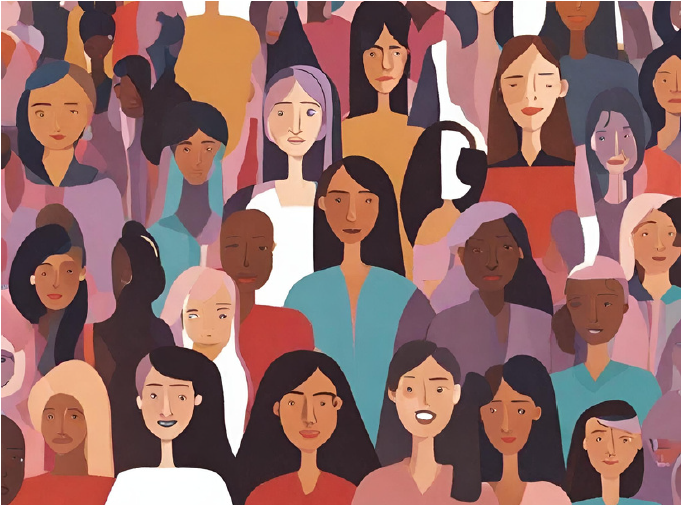In the relentless struggle against Sexual and Gender-Based Violence (SGBV), grassroots movements emerge as transformative agents, steering substantial change within societies. MIFUMI, a non-profit organization, has strategically pioneered the development of a Movement Building Capacity Assessment Tool, a comprehensive strategy aimed at galvanizing communities to challenge the prevailing norms. This article explores MIFUMI’s innovative approach and its profound impact on grassroots movements across areas of intervention. A pivotal element of MIFUMI’s strategy involves mobilizing the wider public affected by SGBV/SRHR injustices and those in solidarity. By empowering movement members to influence change through action within their communities, MIFUMI sparks a groundswell of support against SGBV violations.

By Mathew Ndira
Business Developement Manager – MIFUMI

The Vision for Change
MIFUMI’s Movement Building Capacity Assessment Tool was crafted with a clear vision: to articulate a new paradigm for addressing SGBV and Sexual and Reproductive Health and Rights (SRHR). Serving as a benchmark, this tool empowers movement and network members to gauge progress pre- and post-program interventions. This visionary approach acts as a guiding force for communities striving to instigate enduring change.
Key Domains Measured
MIFUMI’s Movement Building Capacity Assessment Tool focuses on four key domains: Safety and security, Collaboration and coordination, Leadership, and Grassroots Base. Each domain is crucial in constructing are silent and effective movement against SGBV. Whereas these domains proposed are not exhaustive, they best represent the varying contextual differences that prevail throughout the different communities that MIFUMI has been engaged with in the past. We believe that as our work deepens, more lessons will be learnt about what works.
Grassroots Base:
For this work, an effective movement coalesces individuals directly affected by the pertinent issues(SGBV); These same affected individuals evolving to be able to speak for themselves; and the affected movement members increasingly attracting attention from power holders due to collective action.
MIFUMI’s intervention has witnessed a transformative journey on grassroots networks. The impact is evident from the absence of recognized networks to a thriving movement challenging SGBV.
A program annual survey carried out in a rural implementation community in Eastern Uganda revealed that 83% of the survey participants either agreed or strongly agreed with positive grassroots statements describing the progress made towards the establishment and growth of a grassroots-based movement challenging SGBV.
Respondents mentioned that with the intervention of the movement-building program, the organized movement of SGBV champions who live in the beneficiary communities had made a significant difference in community organizing and amplifying voices against SGBV.
Champions equipped with knowledge and skills have become advocates for change, questioning harmful practices and amplifying community voices.
Leadership:
The growth of grassroots leadership in tackling SGBV is a testament to MIFUMI’s success. From limited knowledge and acceptance of SGBV as commonplace, communities now boast champions actively supporting survivors, engaging with local leaders, and initiating campaigns against harmful practices.
At the time of writing this article, there was evidence that across communities where MIFUMI had jointly and individually implemented movement-building initiatives, there was significant change. In one community, 76% of the randomly sampled stakeholders strongly a greed or agreed on positive leadership values of the movement and informal networks that had evolved as community resources to support the SGBV interventions.
A community of SGBV champions, most of whom have had direct experience with SGBV, are organized around Advice Centers and have been equipped with skills and knowledge to support their communities. They have methods of work that guide their interaction with survivors, perpetrators, duty-bearers, and power holders. These protocols give clarity to their aspirations, advocacy, and campaign agendas.
Safety and security
The safety and security domain tracks the movement members’ ability to identify risks and develop response plans collectively; clarify networks and spaces to provide immediate response to SGBV and its ability to provide mental, emotional, and physical health. Addressing safety concerns, MIFUMI has facilitated the creation of safe spaces and improved coordination among safety and security agencies. The intervention has increased awareness and empowered individuals to provide support, transforming communities into safer environments. Of MIFUMI’s Advice Centers, one champion in a community of intervention said:

This pillar is particularly demonstrative of the need to promote sound and collaborative work with local and national level security actors like Police and the broader justice administration system, including the courts of judicature. MIFUMI has had a deliberate and consistent strategy to engage these important stakeholders in our work right from the onset. It calls to task an institution’s stewardship skills.
Collaboration & Coordination:
Assessing the evolution of collaboration and coordination of movements in the target communities involves tracking the ability of movements to develop joint strategies; effect quick and coordinated responses to SGBV; and ultimately discuss successes and challenges openly and honestly. This domain targets duty bearers who have the mandate to deliver Subservices, such as the Police, Probation, Judiciary, and Health Services. The success of MIFUMI’s strategy is evident in the strengthened collaboration and coordination among movement members, survivor groups, and key stakeholders. SGBV steering committees are revitalized, fostering joint strategies to tackle SGBV/SRHR violations.
In Tororo District, it was because of the effective collaboration and coordination between the Sub County and district-level SGBV steering committees that various bylaws and ordinances (including the Bridal Gifts Ordinance, 2009) were achieved over several years of intervention. These laws and ordinances have proved to be very critical investments in the fight against SGBV.

Lessons Learned:
Catalyzing grassroots network change involves embracing collaboration, relinquishing organizational ego for a larger cause, nurturing new leaders, and distributing leadership across the network. Innovation, especially in sparking and sustaining a value system aligned with the movement’s ideology, is key. This includes assuming an adaptive project management and implementation framework. Below are but a few of the lessons we at MIFUMI have learned. These lessons will continue to evolve.
Survivor-Centric Advocacy
MIFUMI has a network of volunteers and survivors in Survivor Support Groups (SSGs) who use the MIFUMI Counselors’ Companion series as a training tool to equip themselves and other survivors to support others. These tools cover counseling principles, MIFUMI values, various presentations of violence, resolution strategies, working with duty bearers, building community support, and more. Additionally, MIFUMI aims to strengthen the policy environment for implementing the Domestic Violence Act (DVA) and the Supreme Court ruling on Bride Price (and other relevant laws and policies) across target regions in a manner that takes the survivor’s needs into full consideration. This knowledge and education offer movement members the bare minimum they need to challenge manifestations of violence and abuse through collective action and assertion within existing legal frameworks.
Building an Evidence Base
In the realm of social change and activism, the success of movements often hinges on their ability to articulate a compelling narrative and mobilize supporters. However, the significance of building an evidence base within movement building cannot be overstated. An evidence base provides a solid foundation upon which movements can construct informed strategies, garner credibility, and effect lasting change. Informed decision-making, grounded in solid evidence, enhances a movement’s ability to develop strategies that resonate with supporters and the wider public.
Moreover, an evidence-based approach adds credibility to a movement, fostering trust among the public and policymakers, which is crucial for sustained momentum and collaboration. Movements armed with a well-documented evidence base can articulate their demands with precision, making data-driven arguments more powerful and persuasive across diverse audiences. Additionally, the adaptability provided by continuous learning and evaluation strengthens a movement’s resilience in the face of evolving challenges. Building alliances is facilitated by an evidence base, enabling effective communication with potential partners and attracting a broader coalition of individuals and organizations committed to shared goals. Some evidence building initiatives that MIFUMI has championed include the research on the link between.
Bride Price, Poverty and Domestic Violence
The significance of building an evidence base in movement building cannot be overstated, as it underpins decision-making, enhances credibility, enables impactful advocacy, fosters adaptability, and facilitates strategic alliances, ultimately increasing the potential for lasting and meaningful impact.
Placing small bets to build resilience
Building resilience in social justice movements involves fostering a strong sense of community and solidarity through open communication and active listening. Prioritizing self-care practices, inclusive leadership, and ongoing education empower activists to navigate challenges and prevent burnout. Celebrating small victories such as policy initiatives, and strategic planning, coupled with adaptability, ensure the movement’s sustainability by recognizing progress and adjusting strategies to evolving contexts.
Establishing effective conflict resolution mechanisms and promoting media literacy and communication skills fortify internal cohesion and external engagement. Intersectionality awareness and a commitment to flexibility round out the holistic approach needed to sustain a resilient social justice movement, addressing the well-being of individuals, community strength, and adaptability in the pursuit of justice and equity.

Conclusion
MIFUMI’s pioneering Movement Building Capacity Assessment Tool has emerged as a catalyst for transformative change in the battle against Sexual and Gender-Based Violence (SGBV). The organization’s commitment to grassroots empowerment, visionary leadership, safety enhancement, and collaboration has laid a robust foundation for movements actively challenging and eradicating SGBV within communities. The tangible impact on grassroots networks, witnessed through the evolution from unrecognized networks to thriving movements challenging SGBV, underscores the effectiveness of MIFUMI’s innovative approach.
The success stories in grassroots leadership, safety and security enhancement, and strengthened collaboration and coordination among movement members and stakeholders further validate the significance of MIFUMI’s strategy. Lessons learned, including survivor-centric advocacy, placing small bets to build resilience, and the importance of building an evidence base, provide valuable insights for future initiatives. As MIFUMI celebrates these successes, the call for ongoing support for initiatives empowering communities in the fight against SGBV remains crucial. The invitation for collaboration with stakeholders emphasizes the collective effort needed to continue building on this body of knowledge, fostering adaptability, and ultimately increasing the potential for lasting and meaningful impact.
MIFUMI’s Movement Building Capacity Assessment Tool stands as a beacon of hope, guiding the way towards a future free from the shackles of SGBV, and the organization welcomes the shared experiences and collaborative efforts of stakeholders in this noble pursuit.
